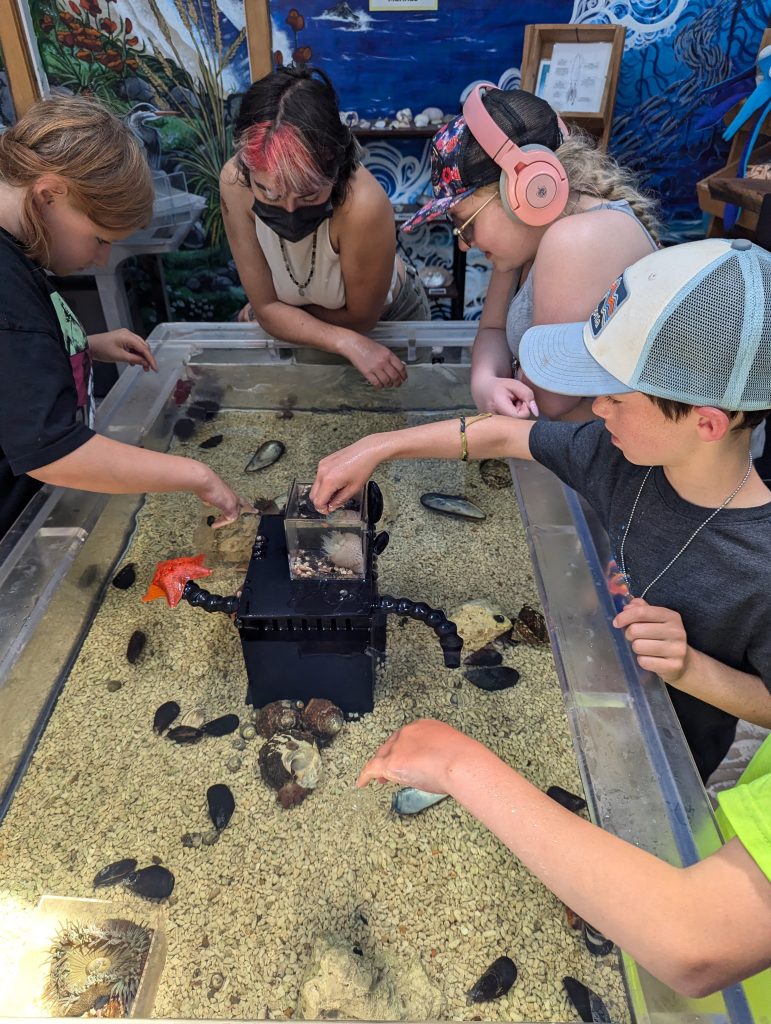This is a guest blog written by our partners at Camp Ocean Pines, a nonprofit camp and conference center in Cambria with year-round programming for kids, adults, and families. Header photo courtesy of Camp Ocean Pines.
From September through May, our small camp facility is bustling with visiting students. In a typical year, we host about 2,000 students from grades 3 to 8, some coming from as far away as Colorado and some as close as five minutes down the road. Our facility, Camp Ocean Pines, is aptly named—we’re a coastal facility boasting both forest and ocean access.
Over this past year, we were able to expand and develop our marine programming thanks to a partnership with the Estuary Program. Our goal is to make content relevant and personal to every student and to interweave concepts as much as possible so that lessons are connective and provide multiple entry points for content. Below are descriptions of some of our standard marine programming and how we were able to enrich those lessons thanks to our work with the Estuary Program.

Tide Pooling
Tide pooling is one of our most requested programs. The tide pools are located just a short 20-minute walk through our Cambrian neighborhood. Our lesson is primarily experiential, letting students explore the area for themselves.
Unfortunately, the local tide pools aren’t always accessible due to tide levels or inclement weather. When this happens, we utilize our recently restored touch tank located in our nature center. The Estuary Program funded repairs to our touch tank and stocking of the tank. All of our invertebrates are humanely captured by divers who have specific training and permits. Our touch tank is currently home to bat stars, giant green anemones, cowrie snails, turban snails, tegula snails, red urchins, purple urchins, striped shore crabs, hermit crabs, and mossy chitons. Kids can touch and hold our touch tank animals, some of which are easily found in local tide pools and some which are harder to find.

Portable Touch Tank
In order to expand our marine programming, the Estuary Program supported the purchase of a portable touch tank. This helps increase equity and accessibility. Not every participant has the ability to visit us in Cambria. So the portable touch tank gives us the opportunity to visit them and still provide high-quality marine programming. We use the portable touch tank for our visits to local schools and also for our partnership with El Camino Homeless Organization in Atascadero and Paso Robles, whom we visit monthly.
Watershed Model
In several of our lessons, such as Indigenous sustainability and marine lab, we touch on conservation with students. We want students to develop a love and appreciation for the natural world and to also understand that they can have a positive impact. Many of our students are not local, and it’s important to us that they’re introduced to ideas or concepts that they can apply back home.
The Estuary Program funded the purchase of a watershed model, which we use to explain how individual actions—even from far away—can impact the ocean and the animals that live there. Our inland students often feel disconnected from the ocean. But, we want them to feel part of this incredible ecosystem, even if it’s not right beyond their doorstep. The watershed model provides a hands-on demonstration of how pollution—everything from farming fertilizer to oil leaks from vehicles—affects marine environments.

Marine Lab
Our Marine lab focuses on ocean ecosystems—who lives there and what exactly is their environment like. In this lesson, we go over ocean zonation. Students get to examine creatures in our touch tank and other animal artifacts (like shells). Through observation, they make educated guesses on which ocean zone the animal would live in.
Extensions of this lesson include cyanotyping and discussing Anna Atkins, an incredible female scientist who used cyanotypes to record scientific specimens; algae and kelp forest lab; and independent tide pool creation. Resources like the touch tank and watershed model are also used to make the content hands-on and relevant.

Here at Camp Ocean Pines, we strive to make outdoor education a meaningful and memorable experience for every student who visits. It is a privilege to live along the California coast. We hope that through thoughtful, connective, and hands-on programming, students leave camp with a greater appreciation and knowledge of the world around them.
As the saying goes, it takes a village to raise and support children. And we are grateful for all of the people and partnerships that allow us to provide enriching education experiences for so many kids.
Help us protect and restore the Morro Bay estuary!
- Donate to the Estuary Program today and support our work in the field, the lab, and beyond.
The Estuary Program is a 501(c)3 nonprofit. As a result, we depend on funding from grants and generous donors to continue our work. - Support us by purchasing estuary-themed gear from ESTERO. This locally owned and operated company donates 20% of proceeds from its Estuary clothing line and 100% of Estuary decal proceeds to the Estuary Program. Thank you, ESTERO!
- Purchase items from the Estuary Program’s store on Zazzle. Zazzle prints and ships your items, and the Estuary Program receives 10% of the proceeds.
- Subscribe to our seasonal newsletter: Between the Tides!
- We want to hear from you! Please take a few minutes to fill out this short survey about what type of events you’d like to see from the Estuary Program. We appreciate your input!